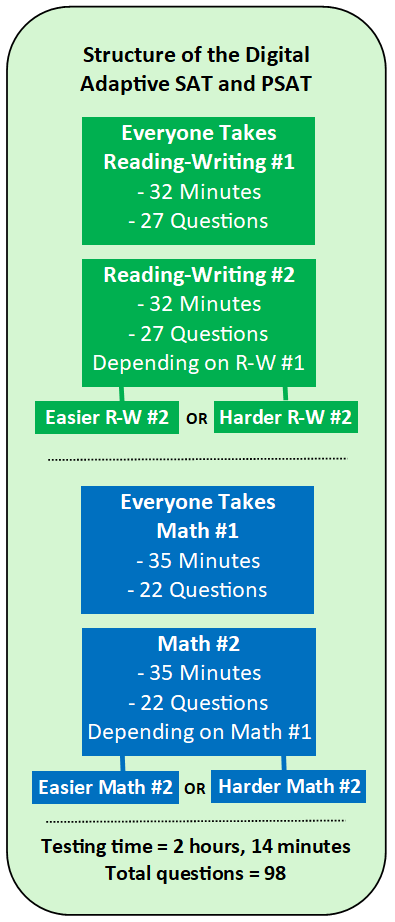The final paper-based SAT test was in December 2023, and the new digital adaptive SAT launched in March 2024. Our first look at the digital adaptive format was in October 2023 when the PSAT began using the same structure.

The digital SAT is administered in proctored settings at schools and test centers, not at home. Students may use their own laptops or tablet devices. This ‘section-adaptive’ testing can assess students’ skills accurately in two hours, 14 minutes instead of three hours for the old paper tests. As shown on the diagram, the digital SAT test has four sections — two for Reading-Writing and two for Math. The results on the first sections determine the level of difficulty of the second sections.
The digital Reading-Writing sections have a combination of reading and writing questions, unlike the former test with two separate sections. Reading passages are much shorter and have only one multiple-choice question per passage. That’s a big change from the former SAT with longer passages and 10 questions per passage.
All math questions on the digital SAT are calculator-allowed. Students may use their own approved calculators, or the graphing calculator using Desmos built into the SAT platform called Bluebook. Like the former SAT, the digital math test includes some grid-in questions, where students must supply the numeric answer (not multiple choice).
The digital SAT continues to be scored on the 1600 scale. On the paper tests, all SAT questions were weighted equally regardless of difficulty. On the digital SAT, harder questions count more than easier ones but there is no such indication to identify that for students. The score reports no longer show raw scores (the number of correct answers). There is no more Question & Answer Service (QAS), a helpful study tool that used to show which questions the student missed. According to the College Board, the official digital SAT test questions will not be revealed at any time. While digital tests are more secure than paper tests, this new process is considerably less transparent.
